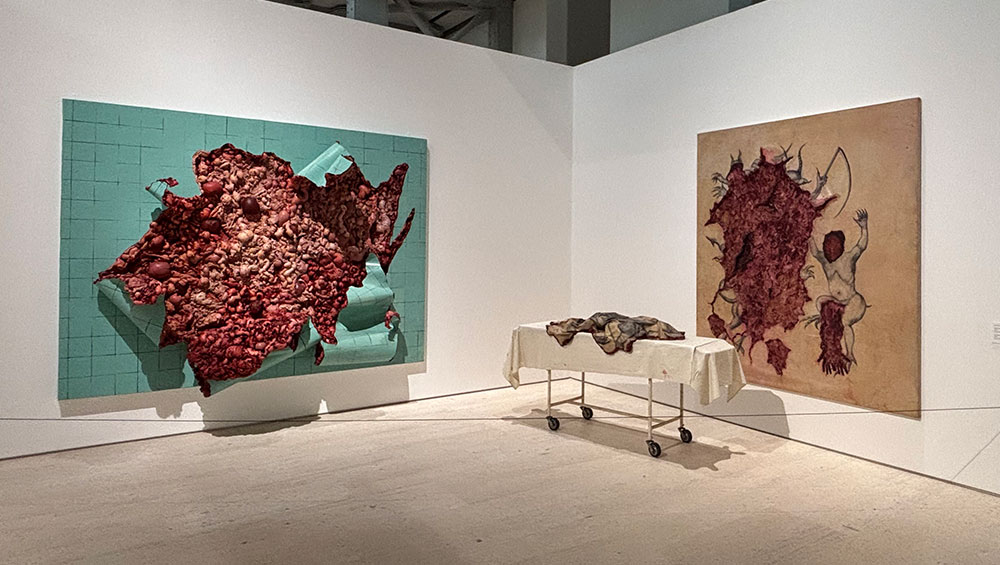
Works by Adriana Varejão in Extirpations room. Installation view, Paula Rego and Adriana Varejão: Between Your Teeth, Centro de Arte Moderna Gulbenkian, Lisbon, 2025. Photo: Caroline Menezes.
Centro de Arte Moderna Gulbenkian, Lisbon
11 April – 22 September 2025
by CAROLINE MENEZES
The Centro de Arte Moderna Gulbenkian (CAM) in Lisbon, Portugal, reopened to the public in 2024 after several years of architectural transformation. An institution dedicated to modern and contemporary art within the Calouste Gulbenkian Foundation, CAM has played a central role in the Portuguese cultural landscape since the 1980s. With its renewed building designed to foster dialogue between artists, artworks and audiences, the current exhibition stages a powerful encounter between two major female artists, whose visual manifestations confront themes such as gender roles, oppression, racial identity, history and political matters – Paula Rego, who was born in Lisbon in 1935 and died in London in 2022, and Adriana Varejão, who was born in 1964 in Rio de Janeiro, Brazil.
It is always a bold and risky move to attempt to rank artists in terms of importance, especially among the many who were working with innovative languages at the turn of the 21st century. We must always ask: in what context, and from whose perspective are they positioned? I have never been particularly fond of hierarchical lists when it comes to artists or artworks. That said, in the specific context of the development of the contemporary art scenes in their respective countries, I would venture to say that Rego and Varejão have indeed made a lasting impact, being among the most influential figures for younger generations in Brazil and in Portugal. Rego is also a prominent name in the UK, where she lived for most of her life. They have also achieved widespread worldwide recognition, with their artworks held in major collections and an extensive record of solo exhibitions at prestigious institutions.
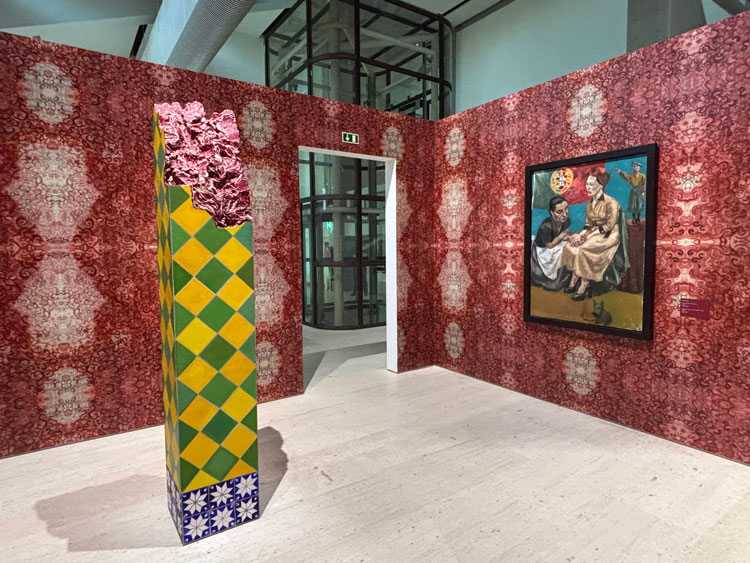
Installation view, Paula Rego and Adriana Varejão: Between Your Teeth, Centro de Arte Moderna Gulbenkian, Lisbon, 2025. Photo: Caroline Menezes.
Evidence of their significance is that each has a dedicated exhibition space in their home country. In Portugal, the Casa das Histórias Paula Rego was inaugurated in 2009 in Cascais, 30km from Lisbon, and houses an extensive body of Rego’s work, including paintings, drawings and prints that span her career. In Brazil, Varejão’s oeuvre has been showcased since 2008 in a purpose-built pavilion at Instituto Inhotim, one of the world’s largest open-air museums of contemporary art, set within a vast botanical garden.
In this light, the survey now on display at CAM offers a rare chance to witness the artistic practices of two distinctive women celebrated at the highest level. Their differences are explicit, yet when placed side by side, they accentuate each other’s characteristics. The curatorial selection is further enhanced by a scenography attuned to the artistic vocabularies of Rego and Varejão, guiding visitors into the depths of their work. It is a virtual maze of rooms, each dedicated to a specific theme. At its core lies a seesaw of emotions and complexities, a play of forces between two strong artists. The attention given to each theme invites the audience to speculate on what the artists bring forward, and in resonance, the voices of Rego and Varejão speak louder together, reverberating fully in the hearts and minds of the public.
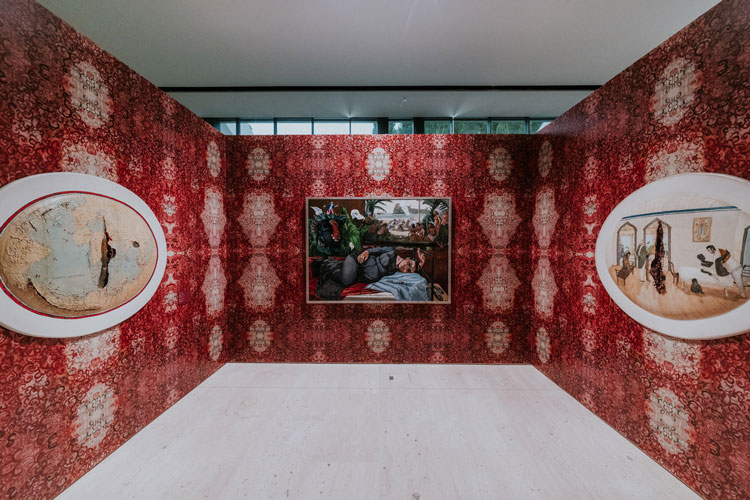
I was a land, a womb, a torn sail. Installation view, Paula Rego and Adriana Varejão: Between Your Teeth, Centro de Arte Moderna Gulbenkian, Lisbon, 2025. Photo: Caroline Menezes.
The exhibition opens with a room titled “I was a land, a womb, a torn sail”, where a historical thread links the two artists to the colonial past. Brazil, Varejão’s homeland, was for more than 300 years a Portuguese territory in the Americas, gaining independence in 1822. Rego, a Portuguese artist who, as mentioned earlier, lived in England (a country itself shaped by the exploitation of other lands), reinterprets a key image in Brazilian art: The First Mass in Brazil, a 19th-century painting by Victor Meirelles, symbol of Brazilian romanticism. Once considered as a civilising milestone, the painting marked the beginning of oppression of the original inhabitants. The scene portrays Indigenous people attending a Catholic mass, evoking the domination of land and bodies that sustained colonial expansion.
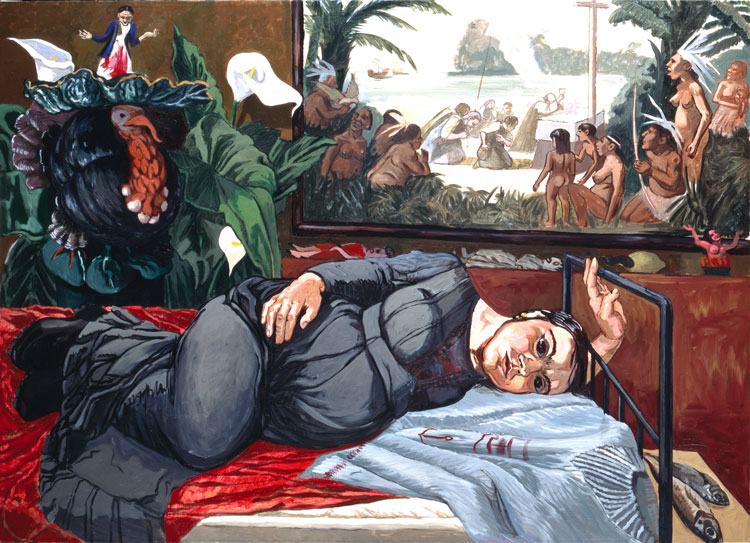
Paula Rego. The First Mass in Brazil, 1993. Private collection.
© The Estate of Paula Rego.
Rego repaints this subject in the background on a 1993 artwork with the same title, while in the foreground, a pregnant woman lies on a red sheet or perhaps blood, in pain. The same colour appears in the wallpaper of the gallery space, with lines echoing the patterns of Portuguese ceramic tiles, but here in red, conceived by Varejão. Rego’s work is placed between two of Varejão’s paintings: Bastard Son II (Interior Scene) (1997) and Map of Lopo Homem (1992).
_Photo-Vicente-de-Mello.jpg)
Adriana Varejão. Bastard Son II (Interior Scene), 1997. Berardo Collection. Photo: Vicente de Mello. © Adriana Varejão.
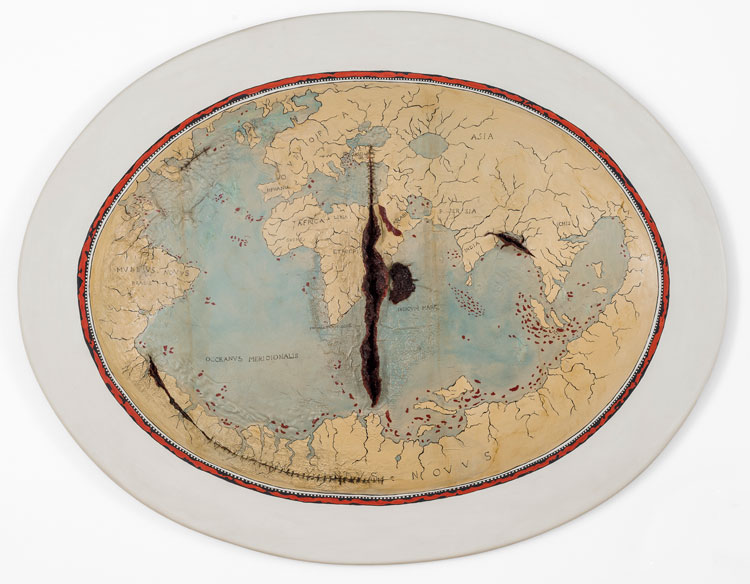
Adriana Varejão. Map of Lopo Homem, 1992. Private collection. Photo: Vicente de Mello. © Adriana Varejão.
The first reinterprets Jean-Baptiste Debret’s famous depictions of enslaved Black people in 19th-century Brazil. In Varejão’s version, Black and Indigenous women appear to be being abused by white Portuguese men, and at the centre of the canvas, a sculptural open wound emerges, a kind of Varejão trademark that also reappears in the world map of the latter work. This opening section sets the tone for the entire exhibition: a productive clash between two women whose voices resonate deeply, speaking in overtones to the audience.
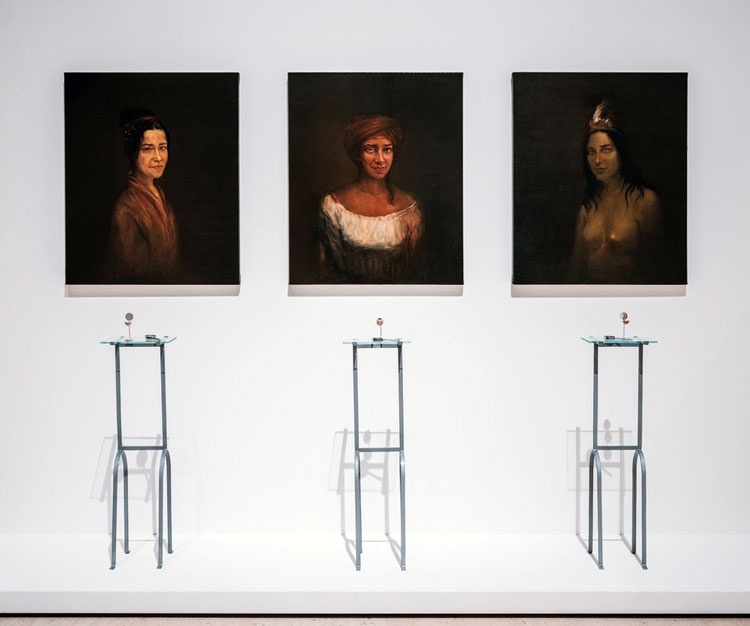
Adriana Varejão. Eye Witness X, Y, and Z, 1997. Oil on canvas, porcelain, photography, silver, glass, and iron, three pieces.
Still within the juxtaposition of colonial histories in the room titled “Memories of Sugar and Salt”, Varejão presents the series Eyewitnesses X, Y, and Z (1997). On the walls are portraits of women from different ethnic backgrounds, painted in a style reminiscent of centuries-old works, though each is striking by the absence of one eye. In front of every portrait stands a small object resembling an optical globe. When looked through, its lens reveals delicate yet brutal scenes, images that suggest the final sights witnessed by each of these women before their death.
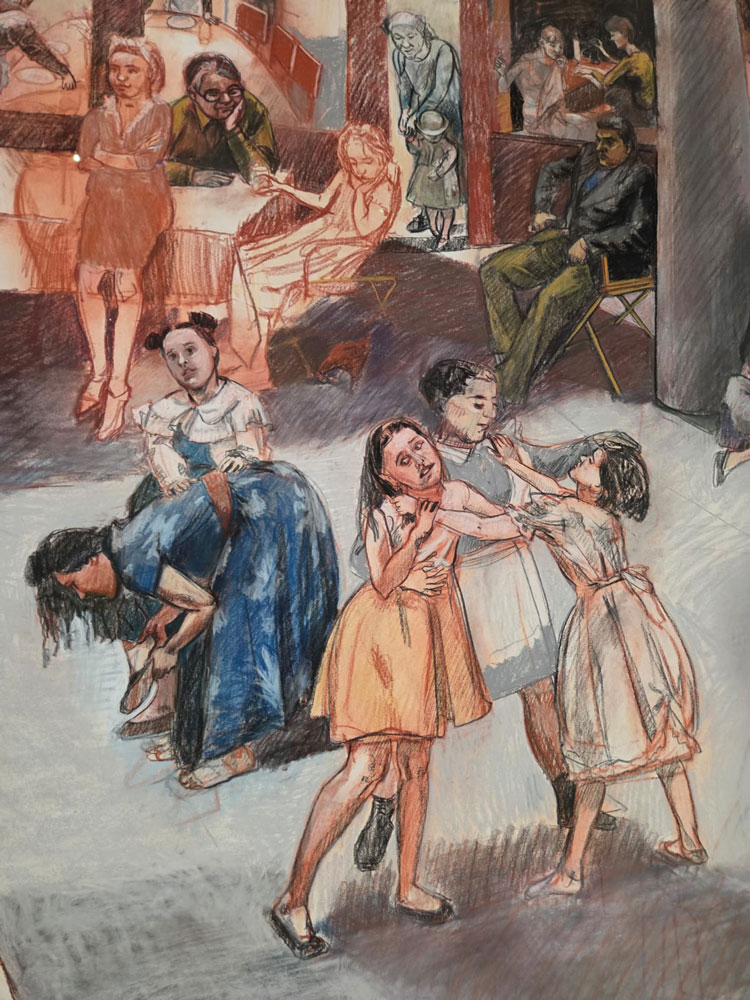
Paula Rego. The Vast Sea of Sargasso, 2000 (detail). Pastel on paper mounted on aluminium. Installation view, Paula Rego and Adriana Varejão: Between Your Teeth, Centro de Arte Moderna Gulbenkian, Lisbon, 2025. Photo: Caroline Menezes.
The work by Rego that accompanies this piece is an unusual diptych made up of a large rectangular canvas and a narrower one beneath it, titled Wide Sargasso Sea (2000). In the upper painting, a densely populated scene unfolds, with figures with intense, and in many cases unhappy, expressions. There are guests, servants and even, unsettlingly, children who form a profoundly psychological narrative. It feels as if this crowd has gathered for some event. In the smaller image below, a woman of mixed ethnicity appears wearing a wedding gown, surrounded by others who all seem to share her suffering, as if the bride has been hidden away from the people above her.
Within this curatorial framework, the discussion centres on mixed identities and the weight of abuse and repression they embody. Yet what also becomes evident, to the eyes of art history, is that both artists are remarkable draughtswomen. Varejão, with her trademark sculptural approach to painting, creates gestures that feel organic, of living flesh, as if the surface has only just been cut open, so that the painting itself becomes a kind of skin. Rego, by contrast, achieves an extraordinary precision through a series of artworks that are, in fact, pastel drawings on paper, but rendered with such mastery and authenticity of line that they appear to have been painted with a brush.
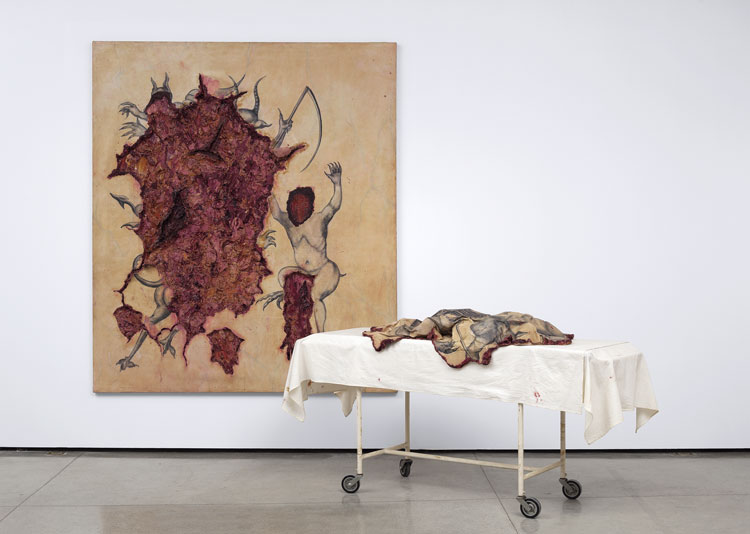
Adriana Varejão. Extirpation of Evil by Incision, 1994. Susana and Ricardo Steinbruch Collection. Photo: Sergio Guerini. © Adriana Varejão.
In each section of the exhibition, the visitor is invited to spend time with the narratives that the artists bring. We can discuss any of them in detail, but before concluding, it is worth mentioning one more room that illustrates these dynamics even more clearly: “Extirpations”, a title borrowed from Varejão’s artwork with almost the same name, Extirpation of Evil by Incision (1994). On the wall, a canvas displays a fragment of torn flesh in deep crimson tones, surrounded by a mythical presence. In front of the painting, placed on a medical stretcher draped with a white cloth, lies a three-dimensional piece resembling a section of skin painted with veins and bruised surfaces, as if echoing the wound depicted in the painting.
_DETAIL.jpg)
Adriana Varejão. Green Tilework in Live Flesh, 2000 (detail). Oil on canvas and polyurethane on aluminium and wooden support. Installation view, Paula Rego and Adriana Varejão: Between Your Teeth, Centro de Arte Moderna Gulbenkian, Lisbon, 2025. Photo: Caroline Menezes.
The installation deals with the fragility of the human body. In another of Varejão’s works in this room, Green Tilework in Live Flesh (2000), the impression is one of an open wound breaking through what could be the sanitised wall of a hospital. The tiled surface suggests hygiene and control, but from its rupture spills a laceration that cannot be closed, exposing raw entrails. Some of the forms that protrude resemble foetal heads, intensifying the sense of unease and impossibility of containment.
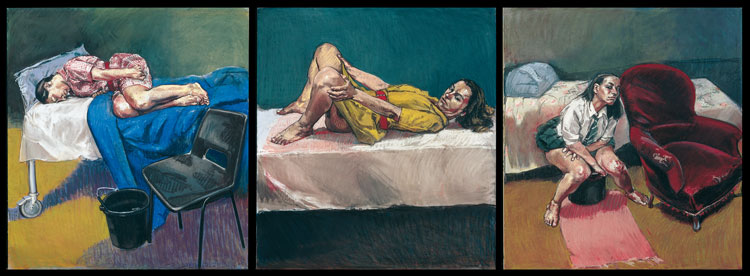
Paula Rego. Triptych, 1998. Reproduced by courtesy of Abbot Hall, Lakeland Arts Trust, England.
This selection of artworks accompanies Rego’s set of three paintings, Triptych (1998), which portrays three women, one in school uniform, whose expressions, despite pain, appear angry and brave. Each woman is alone on a single bed or seated on a bucket, undoubtedly in a precarious situation. This combination of artworks focuses on a polemic social taboo, a female-only experience and a subjective event that has permeated the lives of many women: abortion. These are the kinds of interplay of topics and narratives that the exhibition and its curatorial selection construct for the public. The meanings that arise from the association between the artworks by the two artists make the awareness of such a theme even more straightforward.
The curatorial project of Paula Rego and Adriana Varejão: Between Your Teeth was outlined by Helena de Freitas, an art historian who was formerly director of Casa das Histórias Paula Rego and is now a curator at the Calouste Gulbenkian Foundation, by Varejão, and by Victor Gorgulho, a young Brazilian curator. The scenography was created by Daniela Thomas, an internationally known theatre and film director and multimedia artist. The blend of experience within the group and the sharp eye of Varejão made these dedicated spaces speak to the artistic depth and cultural resonance of Rego and Varejão, two artists whose practices have shaped the way we understand post-colonial history, identity and gender representation today, among other uneasy themes and poetic ideas.